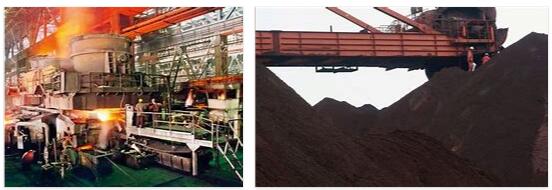Natural resources
Ukraine is rich in natural resources. The deposits of manganese, iron, titanium, coal, graphite and mercury are important worldwide; The proven reserves of uranium, nickel, rock and potash salt, sulfur and cement raw materials are considerable. Manganese ore is mined in the Nikopol Basin, north and east of the Kakhovka reservoir (in the Dnipropetrovsk and Zaporizhia regions). 20% of the world’s manganese deposits are in Ukraine for a long time. Iron ore is stored in the important, around 300 km 2 large basin of Krywyj Rih and in the deposits of Kremenchuk and Belozjorka. The titanium ore deposits are north of Zhytomyr and west of Dniprodzerzhynsk. A world-famous mining industrial area is the Donets coal basin in the east of the country, also due to the productivity of the coal deposits. The smaller Volyn coal basin extends north of Lviv. Lignite, which is stored in a wide area between Zhytomyr and Dnipropetrovsk, is hardly extracted any more.
Petroleum and natural gas, lead-zinc ores, copper ores and bauxite are extracted in Ukraine, but are not available in sufficient quantities for domestic needs. The oil and gas production sites are located in the northern Subcarpathian region, in the Poltava Plain-northern Donets Basin zone and (partly offshore) in the Black Sea-Shelf-North Crimean-Azov Shelf. Before machines, oil and natural gas are the most important and largest import group of goods; they are imported from Russia, Uzbekistan and Turkmenistan.
Energy industry
50% of the electrical energy is generated from thermal power, 45% from nuclear power and 5% from hydropower. The thermal power plants work mainly on the basis of natural gas, followed by coal and heavy oil. They are mainly concentrated in the Donets coal basin, the Dnieper industrial region and near Kiev; the largest have an installed capacity between 2,400 and 3,600 MW. The nuclear power plants are located in the west and south of the country: in Kuznetsovsk (»Rivne«), Netishyn (»Khmelnyzkyj«), Yuzhnoukrajinsk (the South Ukrainian NPP, Mykolaiv region) and Enerhodar (»Zaporizhia«) with installed capacities between 1,000 and 6 000 MW. The “Chernobyl” nuclear power plant was shut down on December 15, 2000. Large hydropower plants are mainly located on the Dnieper; their installed capacities are between 350 and 1,530 MW. A pumped storage plant is also in operation near Kiev. Renewable energies play practically no role. Visit clothesbliss.com for Europe energy.
Industry
The industrialization of Ukraine began in the middle of the 19th century; Industrial development received important impulses in 1930–40 and 1950–70. After the importance of the service sector in the structure of the GDP increased sharply during the 1990s, industry is the second most important economic sector. The most important branches of industry at present in terms of production value are the iron and steel industry (with iron ore mining), power generation, the food industry, mechanical engineering and the fuel industry. Today parts of the Donetsk and Luhansk regions (the Donets coal basin), almost the entire “Dnieper axis” from Cherkassy to Nikopol, are highly industrialized(including Krywyj Rih and Dnipro), most of the other regional capitals with their respective environs (especially Kiev, Kharkiv, Lemberg, Odessa and Mykolaiv) as well as the centers Sevastopol, Melitopol, Berdjansk and Kamianets-Podilskyi.
The Donets coal basin is mainly characterized by hard coal mining and coal refining, mechanical engineering (especially heavy engineering) and iron and steel production, but has shown massive declines in production due to the political unrest. In the Dnieper industrial region, the iron and steel industry (including ore mining), mechanical engineering, non-ferrous metallurgy, armaments and chemical industries dominate. In the Kiev city region, mechanical engineering, precision mechanical and electronic equipment manufacturing, aviation and traffic engineering, light industry (textile, clothing, shoe and leather industries) and a diverse chemical industry are represented. Shipbuilding, located in the industrial centers on the Black Sea coast, is of rather minor importance in terms of its production volume.
Transportation
Ukraine is an important transit country between Central Europe and the Black Sea and Caucasus regions as well as between Northern Europe and Russia as well as Southeast Europe and Asia Minor. The EU programs TACIS and TRACECA (Transport Corridor Europe Central Asia) launched in the 1990s also support modernization projects in Ukraine (such as the expansion of the Berlin / Dresden – Krakow – Lemberg – Kiev transport corridor). Almost half of the railway network is electrified. Inland navigation uses 1,700 km of river stretches, 1,000 km of which are on the Dnieper.
Maritime shipping is based primarily on the spacious port complex Odessa-Illichivsk-Yuzhne, which also includes a container terminal, as well as the ports of Mariupol, Mykolaiv and Cherson; Sea ferry services (especially for goods) connect Illichivsk with Varna (Bulgaria) and Batumi (Georgia), Skadowsk with Zonguldak (Turkey) and Feodosiya with Novorossisk (Russia). With the independence of the country, the importance of international air traffic has grown significantly. The largest airport is Kiev-Boryspil; other important airports with international connections are Lviv, Odessa and Dnipro.
